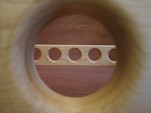hello all,
I'm new to the forum and am about to start wiring my teardrop tomorrow. I've read and researched a bunch on wiring but am still unclear about the two different systems. 12v DC and 120v AC. I am not sure if they co mingle or if they stay independent of each other. If they are separate I'm trying to understand if I need to install a converter to charge the 12v or if a charger is what I would need. I understand 120v easily and don't have an issue there as long as it isn't tied in somehow with the 12 v
I searched on this thread but couldn't find any links to a wiring guide.
Does anyone know of a good link I should refer to?
Thanks
Re: Need advice on wiring
While there are some appliances and lighting fixtures with both 12v and 120v inputs, I believe you should tailor your build for the type of camping you intend to do most.
I plan to mostly camp off grid so the only 120v I will have in my build is the shore power connector to plug in the on board battery charger (when at home), and use a portable solar panel while afield. In the event that I decide to camp where there is shore power and feel the need for 120v appliances I expect to use a multi-outlet power strip and extension cord; essentially no permanently installed on board 120v.
If you want to keep things simple (look in the electrical forum at the "simple electrical" sticky) I would keep the 120v system separate. The other option is a power center that will manage the separate systems for you, including battery charging.
In any event, I would stick with all 12v lighting and only wire 120v outlets for any appliances you might want. The individual wire runs (i.e. circuits) need to be kept separate.
I plan to mostly camp off grid so the only 120v I will have in my build is the shore power connector to plug in the on board battery charger (when at home), and use a portable solar panel while afield. In the event that I decide to camp where there is shore power and feel the need for 120v appliances I expect to use a multi-outlet power strip and extension cord; essentially no permanently installed on board 120v.
If you want to keep things simple (look in the electrical forum at the "simple electrical" sticky) I would keep the 120v system separate. The other option is a power center that will manage the separate systems for you, including battery charging.
In any event, I would stick with all 12v lighting and only wire 120v outlets for any appliances you might want. The individual wire runs (i.e. circuits) need to be kept separate.
KC
My Build: The Poet Creek Express Hybrid Foamie
Poet Creek Or Bust
Engineering the TLAR way - "That Looks About Right"
TnTTT ORIGINAL 200A LANTERN CLUB = "The 200A Gang"
Green Lantern Corpsmen
My Build: The Poet Creek Express Hybrid Foamie
Poet Creek Or Bust
Engineering the TLAR way - "That Looks About Right"
TnTTT ORIGINAL 200A LANTERN CLUB = "The 200A Gang"
Green Lantern Corpsmen
-

KCStudly - Donating Member
- Posts: 9613
- Images: 8169
- Joined: Mon Feb 06, 2012 10:18 pm
- Location: Southeastern CT, USA
